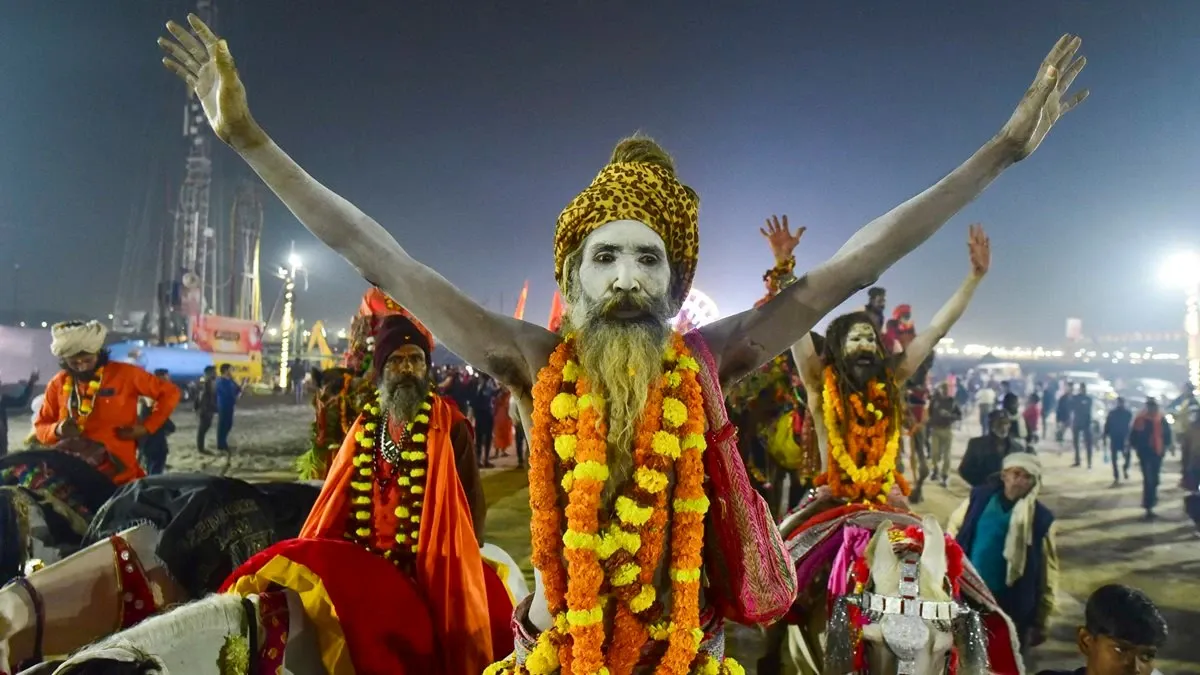Mahakumbh: A Spiritual Odyssey to the World's Largest Religious Gathering!

The Mahakumbh, an awe-inspiring event that happens once every twelve years, is much more than just a festival. It is a spiritual odyssey, an emotional experience, and an event of monumental scale. Drawing millions of devotees, pilgrims, and curious tourists from across the globe, the Mahakumbh is a confluence of faith, culture, and ancient traditions that has transcended time and geography. As the largest religious gathering on earth, it captivates the world with its profound rituals and soul-stirring atmosphere. Let us explore the significance of the Mahakumbh, the history behind it, its various locations, the rituals that define it, and what makes this event an unforgettable experience for those who partake in its spiritual and cultural journey!
Understanding the Mahakumbh
The Mahakumbh is one of the most revered events in Hinduism. It is a grand festival held at four sacred locations in India: Prayagraj (formerly known as Allahabad), Haridwar, Ujjain, and Nashik. The event marks the convergence of heavenly forces and is considered the ultimate opportunity for devotees to seek redemption and cleanse their sins. The festival is believed to have originated from a divine mythological story found in the ancient scriptures.
According to Hindu mythology, the Kumbh Mela was born from the legendary churning of the ocean (Samudra Manthan) in the pursuit of immortality. During this cosmic event, the Gods and demons fought for control over the pot of nectar, or "amrit." In the battle that followed, a few drops of the nectar fell at four locations: Prayagraj, Haridwar, Ujjain, and Nashik. These places, known as Tirthas (sacred sites), became the epicenter of Kumbh celebrations.
The Mahakumbh is a rare occurrence, celebrated only once every 12 years, and it is marked by a cycle of planetary alignments that supposedly magnify the cosmic significance of the event. It is a time when pilgrims from across the world come together to bathe in the sacred rivers, perform rituals, and attain spiritual fulfillment. The magnitude of the gathering is unmatched, often numbering millions, making it one of the largest peaceful gatherings of human beings anywhere in the world.

The Locations: Where the Magic Happens
The Mahakumbh takes place at four locations, each with its own unique significance and vibrancy. Although the event occurs at different intervals, the locations remain constant in their sacredness.
1. Prayagraj (Allahabad)
Prayagraj, located at the confluence of three holy rivers — the Ganges, Yamuna, and the mythical Sarasvati — is considered the most sacred of all Kumbh sites. This confluence is known as the Triveni Sangam, and it is believed that taking a holy dip here washes away one's sins and brings one closer to Moksha, or liberation from the cycle of birth and death. The Mahakumbh in Prayagraj is one of the largest gatherings in the world, attracting millions of devotees, sadhus (holy men), and tourists. The city's vast ghats and temples come alive with devotees chanting hymns, performing rituals, and participating in religious discussions. The energy at Prayagraj during the Mahakumbh is otherworldly — a harmonious blend of devotion, spirituality, and community.
2. Haridwar
Haridwar, situated in the foothills of the Himalayas along the Ganges River, is considered one of the holiest places in India. The Har Ki Pauri ghat is the epicenter of the Mahakumbh celebrations here, where pilgrims come to bathe in the sacred waters of the Ganges to purify their souls. Haridwar is known for its enchanting evening Ganga Aarti, where thousands of devotees gather to offer prayers and light diyas (oil lamps) to the Ganges. The Mahakumbh at Haridwar is characterized by vibrant processions, with thousands of sadhus, saints, and religious leaders coming together to impart wisdom and perform rituals.
3. Ujjain
Ujjain, located in Madhya Pradesh, is one of the ancient cities where the Kumbh Mela is celebrated. Situated on the banks of the sacred river Shipra, Ujjain holds a special place in Hindu mythology as the city where Lord Shiva is believed to have meditated. During the Mahakumbh, the city is decorated with colorful flags and sacred ash, creating a surreal atmosphere. The Mahakaleshwar Temple, dedicated to Lord Shiva, becomes a focal point of pilgrimage and worship during the event. Devotees come to Ujjain to immerse themselves in the spiritually charged atmosphere and take a holy dip in the Shipra River, which is believed to purify them of worldly sins.

4. Nashik
Nashik, situated in Maharashtra, is an ancient city along the Godavari River. It is known for its historic temples and religious significance. Nashik's contribution to the Mahakumbh lies in its sacred waters — the Godavari River is revered as a life-giving force. The Nashik Mahakumbh is a beautiful convergence of sacred rituals, spiritual conversations, and divine processions. It is known for the Kumbh Mela Shahi Snan, a royal bath where thousands of devotees come together to take a ritual dip in the river. Nashik's Mahakumbh also features the Sadhus’ procession, where thousands of holy men, dressed in colorful attire and chanting sacred mantras, march through the streets of the city.
Rituals and Practices: A Sacred Tapestry
The Mahakumbh is marked by a variety of rituals that evoke devotion, reverence, and a sense of awe. The most significant of these rituals is the Shahi Snan or royal bath, during which the largest number of pilgrims take a dip in the sacred river. The timing of the Shahi Snan is meticulously calculated, based on astrological alignments, and it is said that bathing during these auspicious moments brings an immense amount of spiritual merit.
Another central practice at the Mahakumbh is the Puja (ritual worship), where devotees gather in large groups to offer prayers to the gods and seek blessings. The Ganga Aarti at Haridwar and the nightly rituals at Prayagraj and Ujjain are profound, with mesmerizing chants, the sound of bell rings, and the aroma of incense filling the air.
The presence of Naga Sadhus (naked ascetics) adds a unique dimension to the Mahakumbh. These ascetics, who lead a life of intense penance, are a symbol of renunciation and spiritual purity. Their rituals, which often involve fierce meditation, fire rituals, and processions, are integral to the Mahakumbh celebrations.
Another intriguing aspect of the Mahakumbh is the religious discourse and debates held by scholars, saints, and spiritual leaders. These gatherings of divine wisdom draw individuals interested in learning about Hindu philosophy, metaphysics, and spirituality. The sacred air of these gatherings nurtures intellectual and spiritual growth, as ideas and experiences flow freely.

The Cultural Significance
The Mahakumbh is not just about religious rituals; it is also a celebration of India's diverse culture and traditions. It offers visitors a glimpse into a world that is both ancient and alive with energy. The colorful processions of devotees, adorned in traditional attire, the hypnotic beats of drums, the mesmerizing chant of mantras, and the mystical glow of the sacred fire all add to the cultural mosaic of the Mahakumbh.
The event is a true reflection of India’s unity in diversity, where people from different walks of life — rich or poor, young or old, local or foreign — come together with a common purpose: to attain spiritual purification. This unique gathering fosters a sense of shared experience, uniting people across religions, languages, and cultural backgrounds. The Mahakumbh teaches tolerance, respect for nature, and reverence for life.

Travel Tips and Logistics
If you're planning to attend the Mahakumbh, here are a few practical travel tips to ensure that you have a fulfilling and safe experience:
- Timing is Crucial: The Mahakumbh is scheduled based on astrological and planetary alignments, so it is important to check the dates before planning your trip. The Shahi Snan dates are especially crucial for pilgrims looking to take part in the ritual bathing.
- Accommodation: During the Mahakumbh, accommodation can be challenging due to the massive influx of pilgrims. It’s best to book your accommodation in advance or consider staying in nearby towns or camps.
- Dress Appropriately: Since the event is deeply spiritual, dressing modestly and respectfully is a good idea. It’s also advisable to carry comfortable clothing and footwear, as there may be long walks and crowds.
- Safety and Hygiene: The sheer scale of the Mahakumbh means that crowds can be overwhelming. Stay vigilant, keep your belongings secure, and be mindful of personal hygiene. Also, carry basic medications, a water bottle, and snacks.
- Respect Local Traditions: The Mahakumbh is a deeply religious occasion for many. Respect the local customs, traditions, and rituals. Photography is often restricted in certain areas, especially during intimate rituals and ceremonies, so be mindful of where you take photos.

The Mahakumbh is not just a religious festival; it is a pilgrimage that transforms your inner self. It is an opportunity to immerse yourself in the profound teachings of Hinduism, engage with spirituality on a deep level, and experience the unparalleled unity of millions of souls. The event has an energy of its own — one that stirs the soul and leaves an indelible mark on the heart. Whether you are a believer or a curious traveler, the Mahakumbh is a once-in-a-lifetime opportunity to witness the convergence of humanity in pursuit of a higher spiritual goal. It is, truly, a celebration of life, faith, and human spirit.
